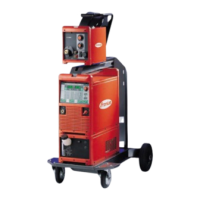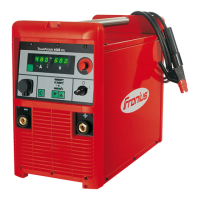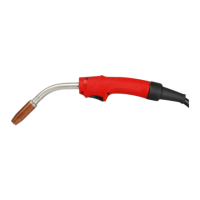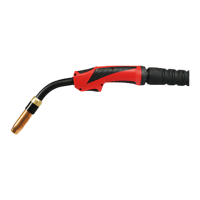Analog job selec-
tion: Principle
Both analog input signals
- are used to generate a numeric value for the corresponding job
- will be in the range 0-10 V
- subdivide this range into 16 steps, each of 0.625 V
A: Part value 1 for “Base current” input signal:
1. Step = Voltage (V)/0.625 V
2. Part value 1 = Step * 16
Example
1. Step = 6.25 V/0.625 V = 10
2. Part value 1 = 10 * 16 = 160
B: Part value 2 for “Duty cycle” input signal:
3. Step = Voltage (V)/0.625 V
4. Part value 2 = Step
Example
3. Step = 6.25 V/0.625 V = 10
4. Part value 2 = 10
C: Selected job:
5. Job = Part value 1 (A) + Part value 2 (B)
Example
5. 160 (A) + 10 (B) = 170
Analog job selec-
tion: highest
selectable job
IMPORTANT! Both analog input signals
- use the highest step 16 for signal recognition
- therefore utilise an effective range of 0 - 9.375 V instead of 0 - 10 V
The highest selectable job is thus:
A: 9.375 V / 0.625 V = 15, 15 * 16 = 240
B: 9.375 V / 0.625 V = 15
C: 240 + 15 = 255
Welding Simula-
tion
ROB 4000/5000 ROB 5000 OC
Signal X14:2 HIGH LOW
The “Welding simulation” signal allows a programmed welding path to be simulated; an
arc, wire feed and shielding gas are not required. The digital output signals „Arc stable“,
„Main current signal“ and „Process active“ are set just as if welding was actually being
performed.
TouchSensing
(ROB 5000/ROB
5000 OC)
ROB 4000/5000 ROB 5000 OC
Signal X8:7 HIGH LOW
The “Touch sensing” signal can be used to indicate that the tungsten electrode has made
contact with the workpiece (short-circuit between workpiece and electrode).
If the “Touch sensing” signal is set, the control panel on the power source shows “touch”.
There will be a voltage of 30 V on the tungsten electrode (current limited to 3 A).
53
EN

